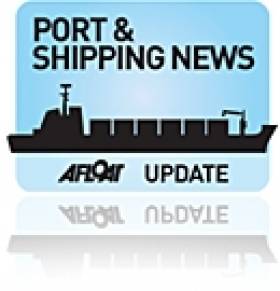Displaying items by tag: Towage
Husky Heads Home from Howth Harbour
#Towage – Alpha Marine’s tug-workboat Husky headed to her homeport of Wicklow Port this morning having been at Howth Boatyard, writes Jehan Ashmore.
The robust looking Belfast registered 8 tonnes bollard pull tug had used the boat-haul or ‘Synchrolift’ facility of the yard. This is operated by John Leonard Shipwright & Co.
Small craft are built at the yard located on West Pier, along with refurbishment and repairs of small vessels all the way up to a 600 tonne trawler. Also to be found lining the West Pier are fishing related businesses among them restaurants using the catch of the day.
Husky over the years has been the mainstay of operations for the multi-disciplinary marine organisation until recently known as Island Shipping.
An example of larger scale work tasked to Husky involved hoving the large Jack-up Barge Wavewalker 1 around Wicklow Port and to the Arklow Bank Offshore Windfarm. Other work has involved use of the workboat’s stern mounted A-frame for bed levelling plough and can be easily configured for multi-beam, geophysical and environmental surveys.
Fleetmates of the Husky are a wind-farm support and crew transfer vessel and an inshore survey-dive crew boat.
Propelled by twin-screws, the 21m Huskey arrived at the Wicklow to berth at the North Quay on the River Vartry. The tug shares the quay with the local fishing trawler fleet. Among them is Angela Madeline, which after a day’s fishing last weekend passed general cargoship Bounder (see report/photo).
In port today, notably is another short-sea trader Velox in which Afloat will have more to report. On the opposite bank at the South Quay is berthed the beam-trawler Bridget Carmel.
Tug that Righted “Rambler 100” Barges Ahead
#TOWAGE – The tug Ocean Bank that righted the capsized US entrant Rambler 100 following the Rolex Fastnet Race 2011, arrived in Dublin Bay recently with a barge under tow, writes Jehan Ashmore.
The Rambler 100 had overturned in force-five winds off Fastnet Rock arising from "dramatic and catastrophic" failure of the keel triggered events that ultimately delayed the rescue of the majority of her 21-strong crew, according to the official report by the MCIB into the capsize.
After the rescue of Rambler 100's crew, the yacht remained adrift but eventually was recovered by the Bere Island based tug Ocean Bank to the shelter of Barley Cove, west Cork. From there the 30 tonne bollard pull tractor tug operated by Atlantic Towage & Marine successfully up-righted the yacht.
This week's operation by the Ocean Bank involved towing a completely different type of vessel, the construction barge Skerchi from the south-west coast to a berth alongside Ocean Pier in Dublin Port.





























































